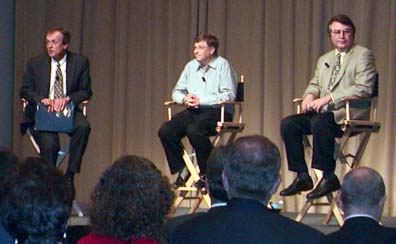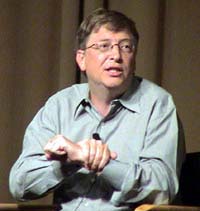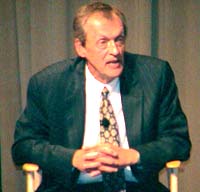Bill Gates Speaks at UCSD
|
5.30.03 - Bill Gates came to UCSD on Tuesday this week to discuss "The Magic of Software in the Digital Decade" and take questions from the audience of students and faculty, including many by high school students from the Preuss School UCSD.
People underestimate how technology will improve things, said Gates, who described IT as the most exciting area, along with biology, to work in over the next 20 years. He pointed to fast and furious advances in hardware, the frequent doubling of the speed of communications, increasingly inexpensive LCD devices, and the spread of wireless. We'll begin to take for granted effectively infinite bandwidth, he said, and, in such an environment, what important new applications will emerge?
|
But Gates admitted that the software, while improving in reliability and simplicity, still isn't yet "rich enough" to support user needs, such as in digital photography and being able to listen to music anytime, anywhere without dependence on particular kinds of media. And there's still a lot to be done to enhance productivity. Gates said that as a result of years of R&D, combined with continuing increases in computer speeds, handwriting and speech recognition will join keyboards as computer input devices in the decade ahead. The Tablet PC, now in its first generation, will be a major platform for these developments.
The proliferation of technology - some 600 million PCs populating the world now used primarily for writing documents, sending/reading e-mail, and browsing the Web - has caused Microsoft to focus more attention on the company's relationship with its users to determine what's causing them frustration and develop ways to provide updates/software fixes in an automated way.
He said the "Holy Grail" for Microsoft is enabling people to become as comfortable reading from computers as from books. It's a tough challenge because people are used to - and demand - high-resolution typefaces and ligatures between letters to enable scanning words quickly. Form factor is an issue, too, because people prefer to read by holding the reading material in their hands.
|
Elaborating on the issue of form factors, Gates commented that all devices - Pocket PCs, tablets, regular desktop systems, cell phones - serve distinct purposes. For example, you wouldn't shop for a refrigerator using the small display device of your cell phone, he said, which elicited laughter from the audience. He mentioned an upcoming product, called a "spot watch," that will be able to monitor the FM sidebands to provide customized information on things of interest to the wearer. It ought to be possible, he said, for software to understand your needs and the context you're in, and, based on that understanding, provide assistance, "like a friend."
Gates said it's also hard to predict how technology will be used, making university campuses such as UCSD, known for their interest in experimentation, the perfect places to find out. Gates lauded the "great grads" from UCSD, many of whom he has hired at Microsoft, and the proliferation of wireless access to the Internet across the UCSD campus. "Here you notice a difference," he said.
Gates, in recent years the Chief Software Architect of his company, said he spends a lot of time reading and writing on "risky things" the company ought to be doing. It's important, he said, for the company to remain open minded about advances taking place around the world.
|
Gates was joined on stage by Chancellor Robert C. Dynes and Larry Smarr, director of Calit², who moderated the questions-and-answers part of the event. Chancellor Dynes noted that, in the last 15 years, most of the great corporate labs, like Bell Labs, had collapsed. Gates responded to that by discussing the relationship between corporate and academic research and said he believed that corporations should support universities through private giving (he has personally given over $100M) and by sponsoring research.
The session drew a overflow audience with 1,000 attendees in the Price Center Ballroom and another 400 in the Price Center theater viewing area. The Webcast drew 215 streams and 438 attempts at peak time (12-1 p.m.), with 19 states tuning in and attendees viewing from China, Canada, several countries in the E.U., and Estonia. This was the highest number of remote viewers by far since Calit² started webcasting invited talks on campus.





